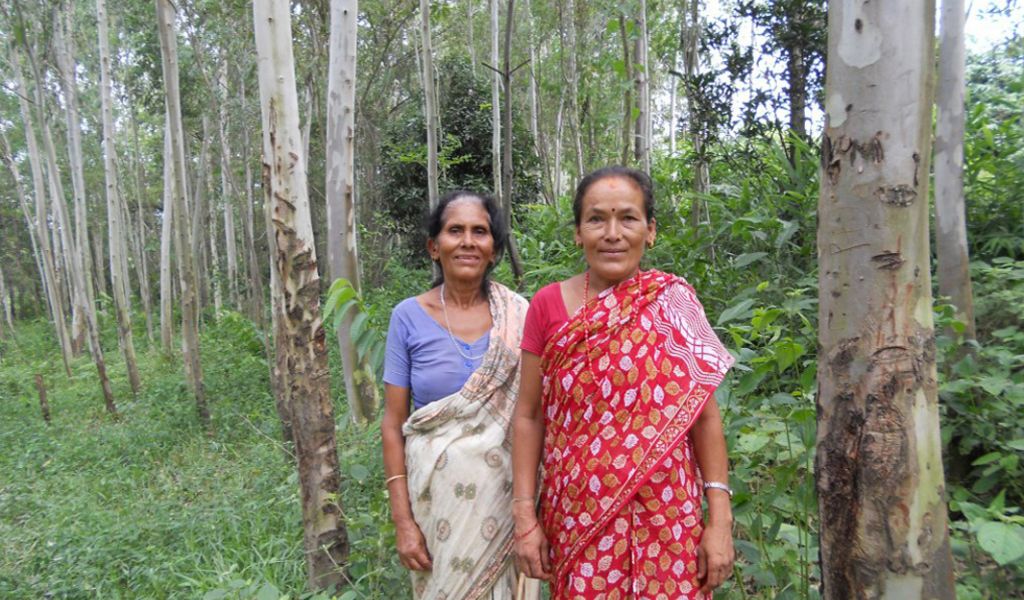Climate change adaptation and mitigation in community managed forests: two sides of the same coin

The women proudly show off the now verdant forest surrounding the Chapini River. As one of the few female-led community forestry user groups (CFUGs) in this conservative area of Nepal close to the Indian border, they represent a success story. They also offer valuable insights into the poorly explored intersection between climate change adaptation and mitigation. The Bishnupur community began planting trees and supporting natural reforestation alongside the river in response to flooding, a phenomenon that Nepal can expect more of as climate induced glacial outbursts increase. Not only were their property and homes buffered from flooding, they began to observe a range of other benefits: improved water retention in areas adjacent to the forests; the community, and specifically the women, had their rights to the forest formally recognized; and finally, even district forest officials acknowledged the significant increases in carbon sequestration.
Until recently, climate change adaptation and mitigation have often been treated as two separate and independent approaches. The study of, funding pots and international discussions on each have taken place largely in isolation. Not only is this ineffective, it is potentially counterproductive. In a just-released publication, “Linking Adaptation and Mitigation through Community Forestry: Case Studies from Asia,” by RECOFTC and its partners (CDKN, REDD-net, Raks Thai and the Adaptation Knowledge Platform), authors argue that it is imperative for the two actions to be integrated. The case studies, covering five countries: Cambodia, Indonesia, Nepal, Thailand and Vietnam), illustrate that there is significant potential for synergies between mitigation activities such as reducing rates of deforestation and supporting adaptive capacities of rural communities (i.e. forest-based sources of livelihoods, strengthening food security and investing in agriculture-supporting ecosystems). But the links are not automatically mutually enhancing. Trade-offs exist and must be incorporated and addressed in project design.
The case studies, while still an early step in teasing out the inter-relationships between adaptation and mitigation, point to concrete examples of where real-life synergies and trade-offs are appearing. In Ban Huay Win, Thailand, for a community located within a national park, conservation-oriented restrictions on land-use prevent community members from adopting potentially more sustainable long-term land management strategies. At the same time, however, the innovative introduction of improved agricultural practices, such as terracing, by NGOs has reduced some of the pressure on forestland, allowing, in some cases, for fallow land to be returned to natural forest regeneration. In the initial example of the Bishnupur community forest, as forest management plans develop, efforts to conserve forest are sometimes at the expense of vulnerable groups. Restrictions on the free grazing of cattle in the forest means that the burden of collecting fodder for stall-raised cattle and the loss of income from dairy as livestock numbers decline fall squarely on women.
Unlike at international levels, the cases underscore that at community levels the distinction between adaptation and mitigation actions is often blurred. The main argument for community forestry, in the context of climate change, is that it responds to multiple interests. Forests, and in particular community forestry, represent a bundle of assets and benefits. They serve as a safety net in times of hardship and support critical ecosystems required for well-being. The cases point out that while the contributions of community forestry to mitigation are well-recognized, in the case of adaptation, community forestry is equally well placed to support adaptive capacity, but this is not automatic. A people-centered approach is required in order to ensure that mitigation or conservation goals are not pursued at the expense of local livelihoods. While community forestry does not inherently ensure improved resilience to climate change, if strategically mainstreamed within community forestry frameworks, it could be a highly effective approach for doing so.
Regan Suzuki is a Project Officer at RECOFTC – The Center for People and Forests and Coordinator for REDD-Net Asia-Pacific.

